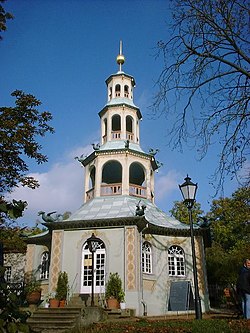Chinoiserie
Chinoiserie refers to elements in European art that are influenced by Chinese arts. Some of the most prominent examples of Chinoiserie can be found in royal palaces in Europe, such as the Drottningholm Palace in Sweden and Tsarskoye Selo in Russia.
Chinoiserie Media
The Yellow Drawing Room at Buckingham Palace is rife with chinoiserie designs. King George IV was a keen patron of chinoiserie, and had many other rooms created in this style such as the Centre Room, also located in the East Wing.
A Vienna porcelain jug, 1799, decorated to imitate another rare Chinese product, lacquerware
Sir William Chambers' Great Pagoda at the Royal Botanic Gardens at Kew, London
Anonymous (France) after François Boucher, "Child Reaching for a Caged Bird", 19th century, engraving and etching
Man seated on plinth, holding monkey and ball. Meissen porcelain. Dated circa 1735. British Museum.
Depiction of a Chinese folding screen as interior decoration in the oil painting Chopin (1873) by Albert von Keller
Painted wallcovering canvas, Geelvinck-Hinlopen Huis
The Chinese House in Potsdam (Germany)
The "Chinese Village" at Tsarskoe Selo, commissioned by Catherine the Great
Other websites
- Chinoiserie from Getty Museum
- "Chinoiserie Style Guide". British Galleries. Victoria and Albert Museum. Retrieved 2007-07-17.










